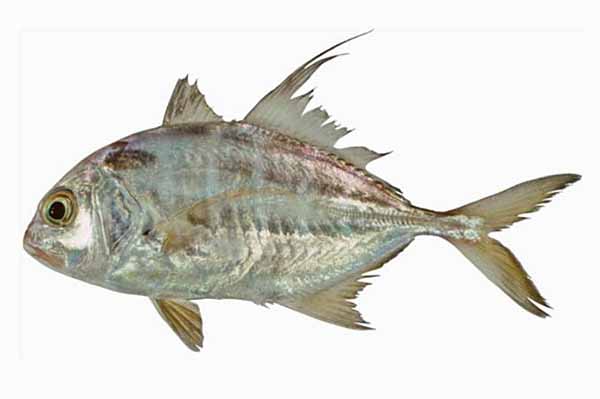Carangichthys humerosus
(McCulloch, 1915)
|
Familie: Carangidae SynonymeCaranx humerosus McCulloch, 1915
Lokale Bezeichnung |
Typen
Holotypus: AMS E.1436 .
Siehe: Eschmeyer, W.N., Fricke, R. & Van der Laan, R. (eds.) 2024. Catalog of Fishes electronic version
Typusfundort: Vor Bustart Head Light, südliches Queensland, Australien.
Etymologie
Humerosus (= mit Schultern), bezieht sich auf einen "großen und auffälligen dunklen Fleck oberhalb der Schulter". (Übersetzt aus: The ETYFish Project)
Verbreitung
Western Pacific and southeastern Indian Ocean: Indonesien und Nordaustralien (Westaustralien bis Queensland); Ausdehnung bis Papua-Neuguinea.
IUCN Status

EX Extinct (ausgestorben)
EW Extinct in the Wild (in der Natur ausgestorben)
CR Critically Endangered (vom Aussterben bedroht)EN Endangered (stark gefährdet)
VU Vulnerable (gefährdet)
NT Near Threatened (potenziell gefährdet)
LC Least Concern (nicht gefährdet)
RE Regionally Extinct (regional oder national ausgestorben)DD Data Deficient (ungenügende Datengrundlage)
NE Not Evaluated (nicht beurteilt)
LC Least Concern (nicht gefährdet)
Gefahren für diese Art: Obwohl diese Art manchmal als Beifang in der Krabbenfischerei gefangen wird, ist der Bestand nicht zurückgegangen, und es sind keine anderen größeren Bedrohungen für sie bekannt.
Literatur
- McCulloch, A.R. 1915. Report on some fishes obtained by the F. I. S. "Endeavour" on the coasts of Queensland, New South Wales, Victoria, Tasmania, South and South-Western Australia, Part III. Biological Results Endeavour, 3 (3): 97-170, Pls. 13-37. Zitatseite [: 137, Pl. 25, !!, als Caranx humerosus]
- Allen, G.R. & Swainston, R. 1988. The marine fishes of north-western Australia. A field guide for anglers and divers. Western Australian Museum, Perth. i-vi + 1-201, Pls. 1-70. Zitatseite [:70, als Carangoides humerosus]
- Kimura, S. & Matsuura, K. (eds) 2003. Fishes of Bitung. Northern tip of Sulawesi, Indonesia. National Museum of Nature and Science, Tokyo. Zitatseite [:74, Autoren: Kimura et al., als Carangichthys humerosus]
- Hoese, D.F. & Gates, J.E. 2006. Various families and subfamilies: pp. 9-61, 63-65, 66-67, 72-73, 74-75, 76-79, 94-95, 125-126, 127-128, 129 -130, 132-133, 134-136, 140-148, 149-152, 158-159, 161-162, 170-172, 235-237, 287-297, 350-356, 357-365, 467-471, 567-574, 741-744, 859-861, 919-910, 1049-1051, 1052-1057, 1148-1173. In: Zoological Catalogue of Australia. Volume 35. Fishes. Pt. 1, 2. Zitatseite [:1154, als Carangoides humerosus]
- Springer, V.G. & Smith-Vaniz, W.F. 2008. Supraneural and pterygiophore insertion patterns in carangid fishes, with a survey of anterior anal-fin pterygiophore insertion patterns in Acanthomorpha, with description of a new Eocene carangid tribe. Bulletin of Biological Society of Washington, 16: 1–73. [1:SAPIPI2.0.CO;2 (doi)] Zitatseite [:29, als Carangoides humerosus]
- Larson, H.K., Williams, R.S. & Hammer, M.P. 2013. An annotated checklist of the fishes of the Northern Territory, Australia. Zootaxa, 3696 (1), 1–293. (doi) Zitatseite [:120, als Carangoides humerosus]
- Kimura, S., Takeuchi, S. & Yadome, T. 2022. Generic revision of the species formerly belonging to the genus Carangoides and its related genera (Carangiformes: Carangidae). Ichthyological Research, Published: 23 January 2022. (doi) Zitatseite [: 46, 47*, Fig 29b, Farbfoto, als Carangichthys humerosus]
